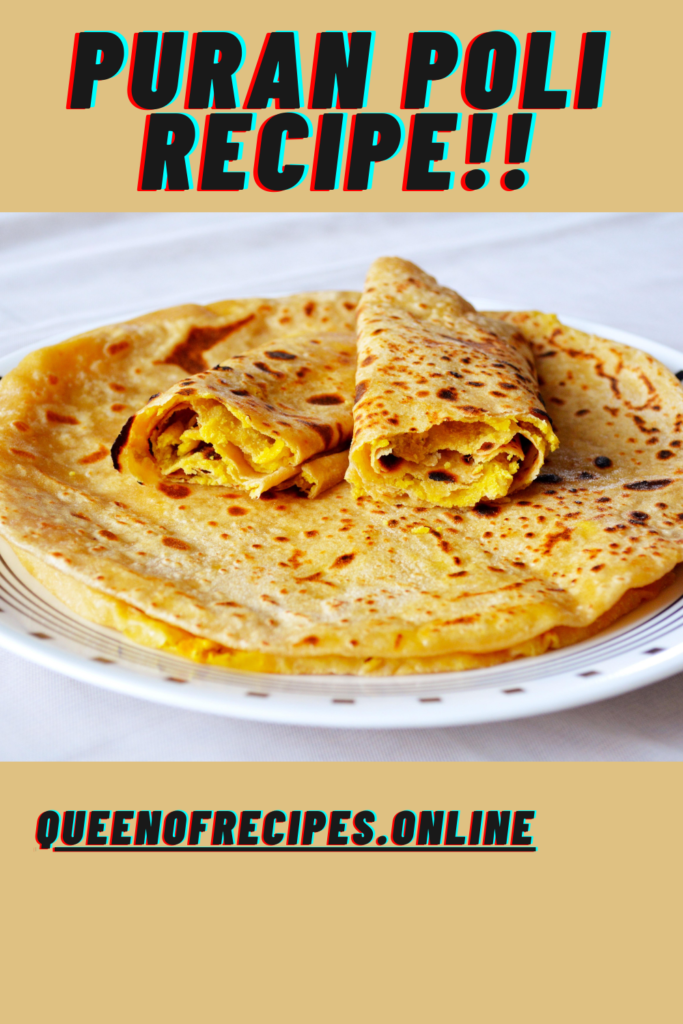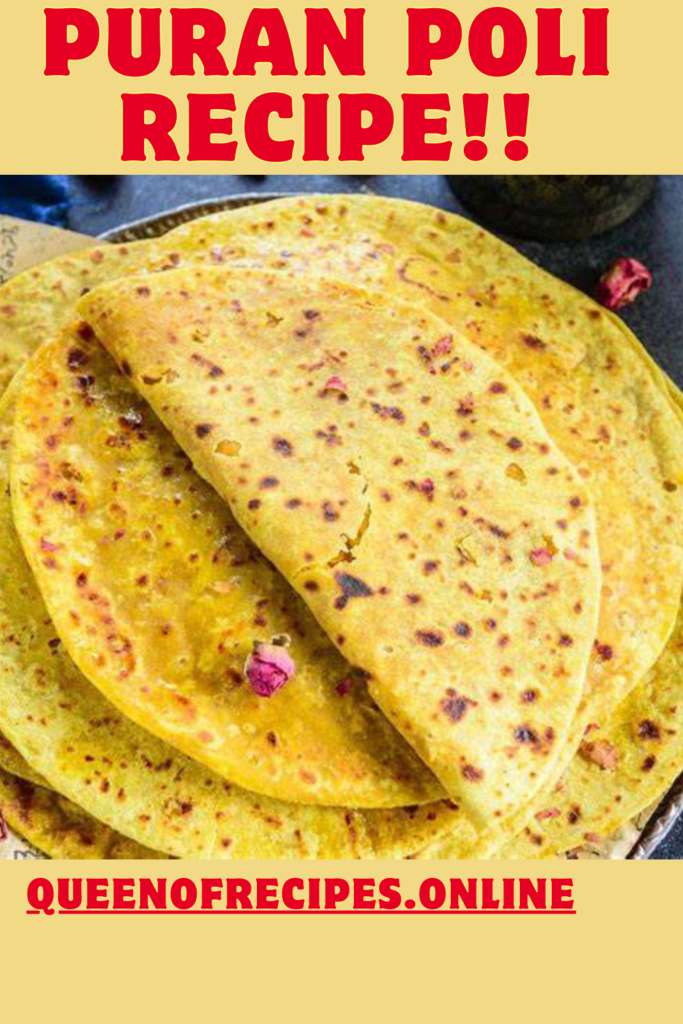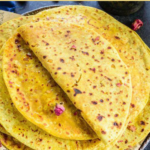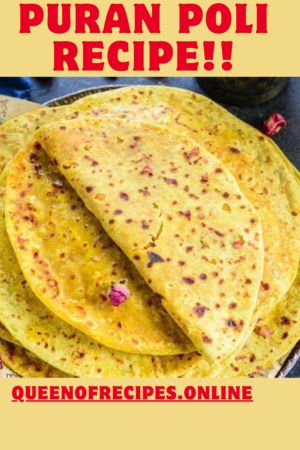Table of Contents
About Puran Poli.
Puran Poli is a traditional Indian sweet flatbread that is popular in the states of Maharashtra, Gujarat, Karnataka, and Tamil Nadu. It is made using a filling of cooked and sweetened lentils or chana dal (split chickpeas), flavored with jaggery (unrefined cane sugar), cardamom, and nutmeg. This filling is encased in a soft and thin dough made from whole wheat flour, often flavored with ghee (clarified butter) or oil. Puran Poli is typically served during festivals and special occasions, and it is enjoyed for its rich, sweet, and aromatic taste. The preparation of it is considered an art, passed down through generations, and it holds a special place in Indian cuisine as a beloved dessert or snack.
To make Puran Poli, follow these steps:
Ingredients: For the filling (Puran):
- 1 cup chana dal (split chickpeas)
- 1 cup jaggery (grated or powdered)
- 1/2 teaspoon cardamom powder
- 1/4 teaspoon nutmeg powder
- Water
For the dough:
- 1 cup whole wheat flour (atta)
- 1 tablespoon ghee (clarified butter) or oil
- Water
- Additional whole wheat flour for dusting
Instructions:
- Prepare the Filling (Puran):
- Rinse the chana dal thoroughly and soak it in water for at least 2 hours.
- Drain the soaked dal and transfer it to a pressure cooker or saucepan. Add enough water to cover the dal.
- Pressure cook the dal until it is soft and cooked through. Alternatively, cook it in a saucepan until tender.
- Once the dal is cooked, drain any excess water and transfer it to a separate bowl. Mash the dal using a potato masher or the back of a spoon until smooth.
- Heat a pan and add the mashed dal along with jaggery. Cook the mixture on medium heat, stirring continuously, until the jaggery melts and blends with the dal.
- Add cardamom powder and nutmeg powder to the mixture and continue to cook until it thickens to a smooth consistency, resembling a thick paste. Remove from heat and let it cool.
- Prepare the Dough:
- In a mixing bowl, combine the whole wheat flour and ghee or oil. Mix well until the ghee is evenly distributed.
- Gradually add water to the flour mixture and knead it into a soft, smooth dough. Cover the dough and let it rest for 15-20 minutes.
- Assemble the Puran Poli:
- Divide the dough into small lemon-sized balls and the cooled Puran filling into slightly smaller balls.
- Take one portion of the dough and flatten it into a small disc using your fingers or a rolling pin. Place one portion of the Puran filling in the center.
- Carefully seal the edges of the dough around the filling, ensuring that no filling is exposed.
- Gently flatten the stuffed dough ball and dust it with whole wheat flour.
- Roll out the stuffed dough ball into a thin circle, using a rolling pin and dusting with flour as needed to prevent sticking.
- Cook the Puran Poli:
- Heat a griddle or tawa over medium heat. Once hot, place the rolled Puran Poli on the griddle.
- Cook for a minute or two on one side until small bubbles appear on the surface, then flip it over.
- Brush some ghee or oil on the cooked side and cook the other side until golden brown spots appear.
- Repeat the process with the remaining dough and filling.
- Serve the Puran Poli:
- Serve the hot Puran Poli with a dollop of ghee or enjoy it as is. It can be served as a dessert or snack.
Enjoy the delicious and flavorful Puran Poli with your family and friends!


Nutritional Value foe Puran Poli.
The nutritional value of it can vary based on the specific ingredients used and the serving size. Here’s an approximate nutritional breakdown for a typical serving of Puran Poli:
- Serving Size: 1 piece (approximately 50-60 grams)
- Calories: Approximately 150-200 kcal
- Total Fat: 5-8 grams
- Saturated Fat: 1-2 grams
- Cholesterol: 0 milligrams
- Sodium: 5-10 milligrams
- Total Carbohydrates: 25-30 grams
- Dietary Fiber: 2-3 grams
- Sugars: 10-15 grams
- Protein: 3-5 grams
It’s important to note that these values are estimates and can vary depending on factors such as the proportion of ghee or oil used in cooking, the type of dal and jaggery used in the filling, and the thickness of the dough. Puran Poli is a sweet dish that is moderately high in calories and carbohydrates due to the presence of jaggery and whole wheat flour. While it provides some protein and dietary fiber from the lentil filling and whole wheat flour, it should be enjoyed in moderation as part of a balanced diet.
Health Benefits of Puran Poli.
Puran Poli offers several potential health benefits, primarily stemming from its wholesome ingredients and traditional preparation methods:
- Good Source of Protein: The lentil (chana dal) filling in Puran Poli provides a significant amount of plant-based protein, which is essential for muscle repair and growth, as well as overall body function.
- Rich in Dietary Fiber: Whole wheat flour used in the dough and the lentil filling contribute to the fiber content of it. Dietary fiber aids digestion, promotes bowel regularity, and helps maintain healthy cholesterol levels.
- Provides Essential Nutrients: Puran Poli contains various essential nutrients such as iron, magnesium, phosphorus, and B vitamins from the lentils and whole wheat flour. These nutrients are vital for energy production, bone health, and overall well-being.
- Moderate Glycemic Index: While Puran Poli contains jaggery, which is a sweetener with a relatively high glycemic index, the presence of fiber from lentils and whole wheat helps moderate the rise in blood sugar levels. However, individuals with diabetes should consume it in moderation and monitor their blood sugar levels accordingly.
- Satiety: The combination of protein, fiber, and complex carbohydrates in Puran Poli can help promote feelings of fullness and satiety, potentially reducing overall calorie intake and aiding weight management when consumed as part of a balanced diet.
- Cultural Significance: Apart from its nutritional benefits, Puran Poli holds cultural significance and is often enjoyed during festivals and special occasions, fostering social connections and promoting cultural heritage.
While Puran Poli can be a nutritious and delicious addition to a balanced diet when consumed in moderation, it’s essential to be mindful of portion sizes, especially for individuals with specific dietary concerns such as diabetes or weight management goals. Additionally, opting for healthier preparation methods, such as using less sweetener or whole wheat flour, can further enhance its nutritional profile.
Tips and Tricks for making Puran Poli.
Here are some tips and tricks to make delicious Puran Poli:
- Soak the Lentils Thoroughly: Ensure that you soak the chana dal (split chickpeas) for an adequate amount of time, typically 2-3 hours, or overnight. This helps soften the lentils and reduces cooking time.
- Pressure Cook the Lentils: Use a pressure cooker to cook the soaked chana dal until it is soft and mushy. This method saves time and ensures that the lentils are cooked evenly.
- Adjust Sweetness: Taste the Puran (sweetened lentil filling) as you cook and adjust the amount of jaggery accordingly. Some prefer their Puran Poli to be sweeter, while others prefer a milder sweetness. Adjust to your preference.
- Flavor Enhancers: Add aromatic spices like cardamom powder and nutmeg powder to the Puran for extra flavor. You can also add a pinch of saffron or a few strands of saffron for a rich aroma and color.
- Knead the Dough Well: Ensure that you knead the dough for it thoroughly to achieve a soft and pliable consistency. This makes it easier to roll out the dough and prevents it from tearing while stuffing.
- Use Ghee for Flavor: While you can use oil for kneading the dough and cooking it, using ghee adds a rich flavor to the dish. Brushing the cooked it with ghee before serving enhances its taste and aroma.
- Roll Thinly: Roll out the stuffed dough balls into thin circles for soft and evenly cooked Puran Poli. Rolling the dough too thickly can result in undercooked centers and a doughy texture.
- Cook on Low to Medium Heat: Cook the Puran Poli on a low to medium heat to ensure even cooking and prevent burning. Flip the Poli occasionally to cook both sides evenly.
- Serve Warm: It is best enjoyed warm. Serve it hot off the griddle with a dollop of ghee for added richness.
- Store Properly: If storing leftover Puran Poli, allow them to cool completely, then store them in an airtight container in the refrigerator. Reheat them gently on a griddle or microwave before serving.
By following these tips and tricks, you can make delicious and flavorful Puran Poli that everyone will love.


Serving Suggestion for Puran Poli.
Here are some serving suggestions for Puran Poli:
- Ghee or Clarified Butter: Serve it with a generous drizzle of warm ghee or clarified butter. The rich flavor of ghee complements the sweetness of the Poli and adds a luxurious touch.
- Milk or Yogurt: Pair Puran Poli with a glass of cold milk or a bowl of creamy yogurt for a delicious contrast of flavors and textures. The coolness of the milk or yogurt balances the warmth of the Poli.
- Chutney or Pickle: Serve Puran Poli with a side of tangy mango pickle or spicy lime pickle for an extra kick of flavor. Alternatively, you can enjoy it with sweet and sour tamarind chutney or coconut chutney.
- Fresh Fruits: Accompany Puran Poli with a platter of sliced fresh fruits such as bananas, mangoes, or grapes. The natural sweetness of the fruits complements the sweetness of the Poli and adds a refreshing element to the meal.
- Dry Fruits and Nuts: Garnish it with a sprinkle of chopped almonds, cashews, or pistachios for added crunch and flavor. You can also stuff the Poli with a mixture of dry fruits and nuts for a richer filling.
- Tea or Coffee: Enjoy it with a piping hot cup of masala chai or aromatic filter coffee for a traditional Indian tea-time treat. The warm beverage enhances the flavors of the Poli and makes for a cozy and comforting snack.
- Ice Cream: For a decadent dessert option, serve warm Puran Poli with a scoop of vanilla ice cream or mango sorbet. The combination of hot and cold, sweet and creamy, creates a delightful contrast that is sure to please your taste buds.
- Festival Feast: During festive occasions such as Holi, Diwali, or Ganesh Chaturthi, serve Puran Poli as part of a festive feast alongside other traditional dishes like sabzi, rice, and sweets. It adds a touch of sweetness and nostalgia to the celebration.
These serving suggestions will help you create a memorable and delicious Puran Poli experience for your family and friends. Feel free to mix and match to suit your taste preferences and dietary needs.
FAQs. for Puran Poli.
Can I make Puran Poli without jaggery?



Yes, you can make Puran Poli without jaggery by using alternative sweeteners such as sugar or brown sugar. While jaggery is the traditional sweetener used in Puran Poli, substituting it with sugar or brown sugar will alter the flavor slightly but still yield a delicious result. Simply replace the jaggery with an equal amount of sugar or brown sugar in the Puran filling according to your taste preferences. Adjust the sweetness as needed and proceed with the rest of the recipe as usual.
How do I prevent the Puran filling from oozing out while rolling the Poli?



To prevent the Puran filling from oozing out while rolling the Poli, follow these tips:
Ensure Proper Sealing: Make sure to seal the edges of the dough properly after placing the Puran filling. Press the edges firmly together to enclose the filling completely.
Roll Out Evenly: Roll out the dough evenly into thin circles. Avoid rolling the dough too thick as it may result in uneven cooking and leakage of the filling.
Even Distribution of Filling: Spread the Puran filling evenly over the rolled-out dough, leaving a small border around the edges. Avoid overfilling the Poli, as this can make it difficult to seal properly.
Press Out Air Pockets: Before sealing the edges, gently press down on the filled dough to remove any air pockets that may cause the filling to leak out during cooking.
Be Gentle While Rolling: Handle the filled dough with care while rolling it out to prevent tearing or stretching. Use gentle pressure to roll the Poli evenly without squeezing out the filling.
Use Flour for Dusting: Dust the work surface and rolling pin with flour to prevent the dough from sticking. This helps maintain the integrity of the dough and reduces the risk of tearing.
By following these tips and techniques, you can ensure that the Puran filling remains intact and does not ooze out while rolling the Poli, resulting in perfectly sealed and delicious Puran Poli.
Is Puran Poli gluten-free?



No, Puran Poli is not gluten-free. It is traditionally made with whole wheat flour (atta), which contains gluten. Gluten is a protein found in wheat and other grains like barley and rye. Therefore, individuals with gluten intolerance or celiac disease should avoid consuming Puran Poli or use gluten-free flour alternatives if they wish to enjoy a gluten-free version of this dish.
Is Puran Poli a dessert or a main dish?



Puran Poli is typically served as a dessert or sweet snack due to its sweet filling and soft, doughy texture. However, it can also be enjoyed as a main dish or part of a festive meal, especially during special occasions and festivals. In Indian cuisine, Puran Poli holds cultural significance and is often prepared and enjoyed during religious festivals and family gatherings as a special treat. Whether served as a dessert or a main dish, it is cherished for its rich flavor and nostalgic appeal.

